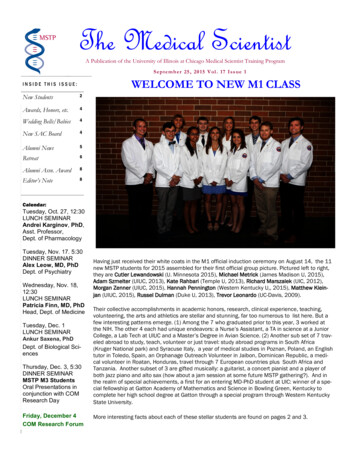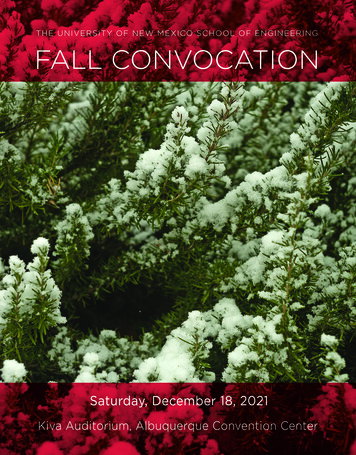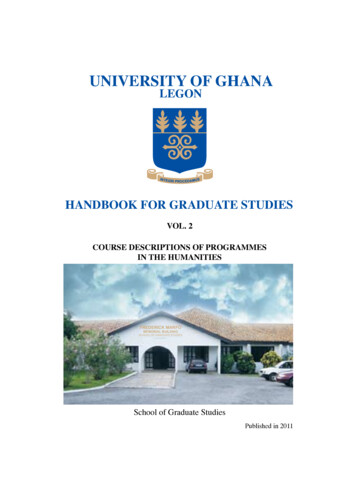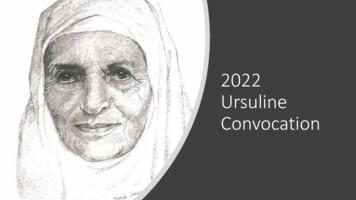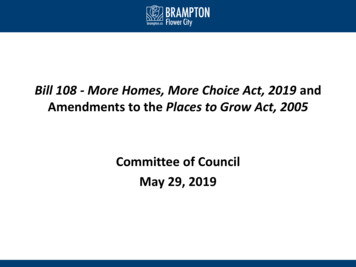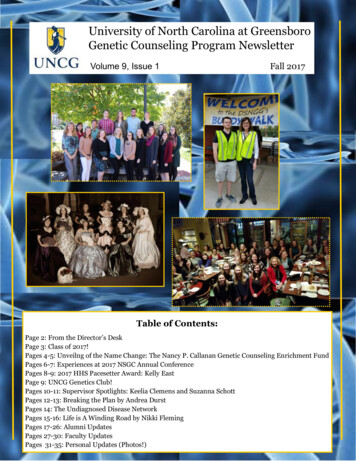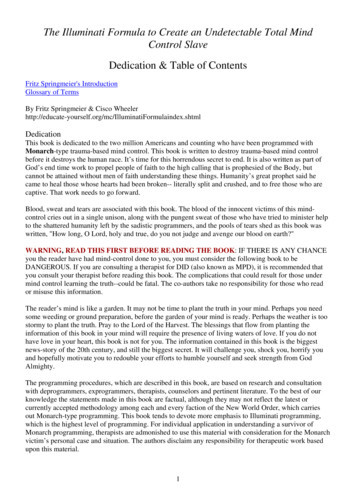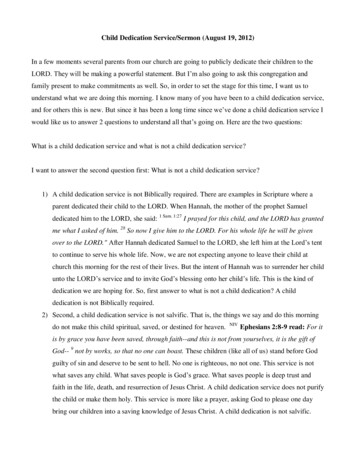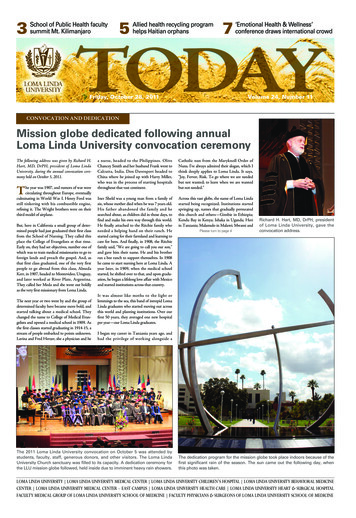
Transcription
3School of Public Health facultysummit Mt. Kilimanjaro5Allied health recycling programhelps Haitian orphans7Friday, October 28, 2011‘Emotional Health & Wellness’conference draws international crowdVolume 24, Number 11CONVOCATION AND DEDICATIONMission globe dedicated following annualLoma Linda University convocation ceremonyThe following address was given by Richard H.Hart, MD, DrPH, president of Loma LindaUniversity, during the annual convocation ceremony held on October 5, 2011.he year was 1907, and rumors of war werecirculating throughout Europe, eventuallyculminating in World War I. Henry Ford wasstill tinkering with his combustible engine,refining it. The Wright brothers were on theirthird model of airplane.TBut, here in California a small group of determined people had just graduated their first classfrom the School of Nursing. They called thisplace the College of Evangelists at that time.Early on, they had set objectives, number one ofwhich was to train medical missionaries to go toforeign lands and preach the gospel. And, asthat first class graduated, one of the very firstpeople to go abroad from this class, AlmedaKerr, in 1907, headed to Montevideo, Uruguay,and later worked at River Plate, Argentina.They called her Meda and she went out boldlyas the very first missionary from Loma Linda.The next year or two went by and the group ofdetermined faculty here became more bold, andstarted talking about a medical school. Theychanged the name to College of Medical Evangelists and opened a medical school in 1909. Asthe first classes started graduating in 1914-15, astream of people embarked to points unknown.Lavina and Fred Herzer, she a physician and hea nurse, headed to the Philippines. OliveChancey Smith and her husband Frank went toCalcutta, India. Don Davenport headed toChina where he joined up with Harry Miller,who was in the process of starting hospitalsthroughout that vast continent.Catholic nun from the Maryknoll Order ofNuns. I’ve always admired their slogan, which Ithink deeply applies to Loma Linda. It says,“Joy, Fervor, Risk. To go where we are neededbut not wanted; to leave when we are wantedbut not needed.”Iner Sheld was a young man from a family ofsix, whose mother died when he was 7 years old.His father abandoned the family and hesearched about, as children did in those days, tofind and make his own way through this world.He finally attached to the Ritchie family whoneeded a helping hand on their ranch. Hestarted caring for their farmland and learning tocare for bees. And finally, in 1908, the Ritchiefamily said, “We are going to call you our son,”and gave him their name. He and his brotherran a bee ranch to support themselves. In 1908he came to start nursing here at Loma Linda. Ayear later, in 1909, when the medical schoolstarted, he shifted over to that, and upon graduation, he began a lifelong love affair with Mexicoand started institutions across that country.Across this vast globe, the name of Loma Lindastarted being recognized. Institutions startedspringing up, names that gradually permeatedthis church and others—Gimbie in Ethiopia;Kendu Bay in Kenya; Ishaka in Uganda; Heriin Tanzania; Malamulo in Malawi; Mwami andPlease turn to page 4Richard H. Hart, MD, DrPH, presidentof Loma Linda University, gave theconvocation address.It was almost like moths to the light orlemmings to the sea, this band of intrepid LomaLinda graduates who started moving out acrossthis world and planting institutions. Over ourfirst 50 years, they averaged one new hospitalper year—our Loma Linda graduates.I began my career in Tanzania years ago, andhad the privilege of working alongside aThe 2011 Loma Linda University convocation on October 5 was attended bystudents, faculty, staff, generous donors, and other visitors. The Loma LindaUniversity Church sanctuary was filled to its capacity. A dedication ceremony forthe LLU mission globe followed, held inside due to imminent heavy rain showers.The dedication program for the mission globe took place indoors because of thefirst significant rain of the season. The sun came out the following day, whenthis photo was taken.LOMA LINDA UNIVERSITY LOMA LINDA UNIVERSITY MEDICAL CENTER LOMA LINDA UNIVERSITY CHILDREN’S HOSPITAL LOMA LINDA UNIVERSITY BEHAVIORAL MEDICINECENTER LOMA LINDA UNIVERSITY MEDICAL CENTER – EAST CAMPUS LOMA LINDA UNIVERSITY HEALTH CARE LOMA LINDA UNIVERSITY HEART & SURGICAL HOSPITALFACULTY MEDICAL GROUP OF LOMA LINDA UNIVERSITY SCHOOL OF MEDICINE FACULTY PHYSICIANS & SURGEONS OF LOMA LINDA UNIVERSITY SCHOOL OF MEDICINE
TODAY2Friday, October 28, 2011OUTREACH TO SENIORSSchool of Pharmacy grant may haveended—but outreach continuesBy Stephen Vodhanel, PhDriginally funded by the Amgen Foundation, the Partners-in-D grant enabled theSchool of Pharmacy to send pharmacy studentsdirectly into several community facilities to helpunderserved seniors choose a Medicare Part Dprogram that best suits their individual needs.OThe Partners-in-D grant supported three yearsof sending pharmacy students into nearbysenior centers and provided excellent experiential education regarding the needs of the elderlywith understanding of the daunting task ofchoosing the best Medicare Part D prescriptiondrug plan.However, as the Amgen Foundation Partnersin-D grant has passed, the School of Pharmacyremains committed to serving elderly residentsby continuing the same community serviceoutreach dedicated to the Medicare Part Dgrant program.During the past three years School of Pharmacystudents and faculty were able to save manyMedicare patients thousands of dollars. It wasnot uncommon to have a single Medicarepatient see a savings of more than 2,000through proper Part D enrollment. The Schoolof Pharmacy will remain committed to thisservice to the elderly for the foreseeable future.The School of Pharmacy’s involvement withPartners-in-D offers valuable experientiallearning for pharmacy students by providing theopportunity to work directly with individualpatients, often with complicated drug regimens,in a manner that evaluates cost efficiencies in theMedicare system. The Partners-in-D experience allows pharmacy students the real-worldopportunity to help seniors get the best andmost appropriate coverage for their medicationswhen possible. Partners-in-D prepares studentsfor future work with elderly patients and buildsa foundation for them to become vital advocatesfor elderly medication needs.Joycelyn Yamzon, PharmD, director of thePartners-in-D grant, sees the value ofassisting the elderly, as well as the experientialeducation benefit the Partners-in-D programMedicare Part D outreach activities remain an important source for experientialeducation. Here pharmacy students assist a senior citizen in choosing options.provides. “For our students that are not doingrotations yet, this program gives them a greatopportunity to apply classroom informationof a complicated Medicare enrollmentprogram to elderly citizens who would otherwise be so vulnerable without assistance,” saysDr. Yamzon.The School of Pharmacy has also expanded sitevisits for the 2011 enrollment period with theMedicare Part D program.The Loma Linda City Senior Center, as withnew senior housing projects have been added toan existing list of several senior housing projects.COMMUNITY PLANNING SUMMITUpcoming summit to encouragecommunity planning around healthBy Heather Reifsnyderhe School of Public Health will host thesecond annual Healthy Communities byDesign summit November 14 and 15 at LomaLinda University and at the Economic andSocial Research Institute (ESRI) headquartersin Redlands.TThe design of healthy communities bringsgeographic analysis into urban and suburbandesign processes that seek to promote humanhealth. The summit will provide a forum toexchange ideas on environmental factors thataffect health and to discuss new communityplanning approaches that incorporate healthconsiderations.“It is my hope that through the HealthyCommunities by Design Summit, the value andapplication of geospatial technologies incommunity health, urban planning, and thebuilt environment will create a positive impacton human health within our communities,” saysSeth Wiafe, MPH, director of the summit andcoordinator of the school’s health geoinformatics program.Sandra Witt, DrPH, will open the summit bydiscussing how to achieve livable communities.She has more than 20 years of experience inpublic health and currently oversees the California Endowment’s healthy community initiative in the northern half of the state. Theendowment is a private foundation dedicated topromoting affordable, quality health care andimproved health for all Californians.A panel discusses community planning during last year’s summit.Another key speaker, Bill Davenhall, MA, willexamine community design through the use ofgeographic information systems (GIS). Hecurrently manages the health and humanservices marketing team for the Redlands-basedcompany ESRI, a global leader in developingGIS software to help solve human problems,including those related to public health.Throughout a career of more than 30 years, hehas focused on applying geographic and demographic data to issues ranging from health caredemand to business expansion.FACULTY EXCELLENCEOccupational therapy professor fillstextbook void by writing her ownBy Heather Reifsnydereather Thomas, PhD, always struggled tofind a current and accurate textbook forteaching activity analysis to occupationaltherapy students. So she took charge and wroteone. The recently released volume, OccupationBased Activity Analysis, debuted in July fromeducational publisher SLACK Inc.HActivity analysis is a skill occupational therapistsmust use in order to help their clients learn howto complete tasks. The simplest act, such aspicking up a glass for a drink, requires dozens ofcognitive and physical elements workingtogether—range of motion, vision, balance,strength, coordination, proprioception, etc.Activity analysis is the breaking down of suchtasks to their essential components in order todiscover the causes of performance problems, aswell as to find activities that will help address aclient’s deficits.After seven years of leading the class without aRobert Ogilvie, PhD, will give a presentationdrawing upon 15 years spent focusing oncommunity planning and development for lowand middle-income neighborhoods. Today, hedirects the Planning for Healthy Placesprogram at the organization Public Health Law& Policy.A full list of speakers, the summit agenda, andonline registration can be found at www.llu.edu/public-health/hcbd .textbook, this quarter Dr. Thomas is teachingfrom her own for the first time.“It is a sense of completion,” she says. “It feelsgood to see the students finally have a completeresource—not just my notes—that they cancarry with them and refer back to for help in thenext few years of their education and earlycareer.”Dr. Thomas, who has 13 years of clinical experience as an occupational therapist, joined theLLU faculty in 2004. Until now, she has alwaysused her own notes and various other resourcesto teach activity analysis.Having run into a publisher at an annual occupational therapy conference several years back,General registration for the summit is 25. Forthose seeking continuing education hours, registration will cost 50. The latter includes 13units of credit.The following professionals may receive continuing education credit: certified health educators,chaplains, marriage and family therapists, occupational therapists, physical therapists, registereddietitians, registered nurses, respiratory therapists, social workers, and speech pathologists.Dr. Thomas suggested his company produce atextbook for this course. He revealed that hehad heard the same suggestion from others.Discovering her previous experience inpublishing journal articles, he asked, “Have youthought about writing it?”When they ran into each other again the nextyear, he asked her once more. She agreed towrite a couple of chapters for SLACK Inc. toevaluate. Upon seeing her initial work, thecompany immediately signed a contract forthe book, saying there was a huge need forsuch a text.For three years, Dr. Thomas worked on thebook. She not only wrote the text, but sheContinued next page
Friday, October 28, 20113TODAYFACULTY ACHIEVEMENTFour School of Public Health facultysummit Mt. Kilimanjaro in 2011By Janna Vassantacharthis year, four School of Public Healthfaculty members followed their ownteachings on personal wellness to summitMount Kilimanjaro—the highest mountain onthe African continent.TThe grueling round trip took a total of six days,with more than four of those days spentascending. The faculty members faced physicaland mental challenges to achieve their goal.Three of the faculty members—Joan Sabaté,MD, DrPH, chair of the nutrition department;Ronald Mataya, MD, associate professor ofglobal health; and Mickey Ask, MD, assistantprofessor of health promotion and education—traveled in a group of eight to Tanzania in lateJanuary. Their goal was to hike to the highestpoint of Kilimanjaro, Uhuru Peak. Rising to analtitude of 19,341 feet, Uhuru Peak is located onthe Kibo crater rim. Kibo is the highest of thethree volcanic cones that compose Kilimanjaro.Drs. Sabaté, Mataya, and Ask reached UhuruPeak by the Umbwe Route. This route is one ofthe most spectacular routes and goes directly tothe peak, but it is also the toughest and leastused due to steep slopes, narrow ridges, andglaciers, according to Dr. Mataya. The route isadvised only for the fit, experienced climberwho enjoys trekking.Along with climbing Kilimanjaro, Dr. Sabatéalso traveled to Kenya to assess the fieldwork ofa DrPH graduate, Hellen Ndiku. She receiveda Nestlé Foundation grant to conduct a pilotstudy on the reintroduction of pearl millet, anative crop, into the diets of young children inrural Kenya.The fourth faculty member, Tricia Murdoch,MPH, director of enrollment management, wasin Kenya at the end of June with a group fromthe Loma Linda University Church. She andthe group worked with Mara West, an organization that runs safaris and builds clinics andschools for the local Maasai population. Afterassisting the organization for a week, she drovenine hours to Tanzania to make the climb witha group of 19.The four faculty members endured the physicalhardships of the long hike, little sleep, and lackof oxygen at the high altitudes. They alsobattled the urge to give up. Dr. Mataya says,“My mind kept asking me why on earth I wasdoing this.”For Dr. Sabaté and Ms. Murdoch, the mostchallenging part was the night of the final assent.Dr. Sabaté says the night was very dark and cold,and they needed to climb more than 4,500 feet.Ms. Murdoch says they ascended “rapidly andthe whole experience was very disorienting.”But, with the support of their groups and motivating guides, the four faculty members reachedthe peak, and recall feeling exhilarated with thesense of accomplishment and the spectacularview. “Although it was freezing cold and verywindy, the view was just magnificent!” says Dr.Mataya. “The giant glaciers, the crater, and thesun rising above the clouds was a view that I willnever forget!”Wayne Dysinger, MD, MPH—assistantprofessor of health promotion and education,as well as health policy and management—also summited Kilimanjaro years ago when hewas a student missionary. He remembers theview as giving him “the feeling of being on topof the world.”The success of Kilimanjaro was not achievedwithout dedication and commitment, noted thefaculty members. They needed to train andensure they were physically capable ofcompleting the hike. Nutrition also needed tobe considered. These School of Public Healthfaculty members dedicated time outside of theirdaily roles as professors and physicians toincrease their wellness and accomplish their goalof standing at the highest point of the Africancontinent.Continued from previous pagecrafted worksheets, diagrams, and charts andtook all the photographs.“The purpose of our writing group is to nurturea culture of writing and scholarship within theoccupational therapy department where facultyoffer accountability, differing perspectives, andbrainstorming on each other’s writing projects,”says Christy Billock, PhD, chair of the writinggroup and associate professor.Other OT faculty members have also been busywriting books, book chapters, peer-reviewedresearch articles, and pieces for professionalpublications and the community.Heather Thomas earned her master of arts inALUMNI ACHIEVEMENTFrom student to pharmacist to preceptorto corporate managerBy Steve Vodhanel, PhDFor Greg Harrington, PharmD, the challengeof pharmacy school was extensive, but the challenges of career opportunities moved all too fast.In a period of less than two years, Dr.Harrington has progressed from student, topharmacist, to pharmacy manager, to preceptor,to corporate professional whose responsibilitiesinclude special projects in the Las Vegas area.He also has received the Region 72 ParagonAward for CVS, which gives the honor solely toits top performers.“The pharmacy profession is vast with manycareer opportunities,” says Dr. Harrington. “It isvery important as an intern to gain as muchexperience as you can. As a pharmacist, onceyou are licensed your perspective of the profession changes and career opportunities canhappen very quickly. Hopefully you areprepared to make an informed decision.”Dr. Harrington does find the time to assist theSchool of Pharmacy by precepting students in amanner beneficial to both students andCVS/Caremark.“I was fortunate to work with great preceptors,some who have been pharmacists for 25 and 30years, and this made a huge impact on me,” Dr.Harrington points out. “And, I want to makesure I have the opportunity to influence otherstudents. As a preceptor, I get a chance to usemy experience in making students become goodpharmacists in the same manner as thosepreceptors who helped me. I have this saying learn the hard way by yourself, or learn the easyway through the experience of others. And inthis profession, learning the hard way by yourself can be a costly mistake.”She drew support during the long writingprocess from her fellow educators by participating in the OT faculty writing group.“Heather’s book publication represents some ofour progress in further cultivating a scholarlyculture within the department of occupationaltherapy.”The sign proves it: a windblown Tricia Murdoch, MPH, indeed reached thesummit of Kilimanjaro.Reprinted with permission fromSLACK Incorporated: Thomas H. Occupation-Based Activity Analysis. Thorofare, NJ: SLACK Incorporated; 2012.occupational therapy from the University ofSouthern California in 1998. This summer, thesame month her book was published, she graduated with her PhD in health science/healthcare administration.According to Dr. Harrington, precepting isalso a valuable experience for any corporate orprofessional entity. “Through precepting weget a real close look at a student’s skills andknowledge, but also how they will handlethemselves in an often stressful situation thatdemands good people skills,” he explains.“Students need to understand that the pharmacy profession truly is a small family and thatevery rotation is a potential audition for a job.Take each rotation seriously and work profes-sionally, as you may meet these same peoplelater in your career, or, and this is common,someone in an interview will know that personwhom you once worked under.”Dr. Harrington also simply enjoys theprecepting experience. “It’s fun and a great wayto stay in contact with your school,” he shares.“Every six weeks or so we get to meet anotherstudent on their path to becoming a pharmacist,and we look forward to this time. We’ve hadsome really great students, and actually hired afew along the way.”“But as a last thing, show me a pharmacist whomade it without preceptors,” Dr. Harringtonasserts. “We all owe it to our profession to takeon the responsibility of precepting, as those didbefore us. As a student, if you had a great experience during a rotation, as a preceptor try toemulate that same great experience. If you had aterrible experience during a rotation, learn fromthat experience to make your interaction withstudents better.” He adds, “Precepting is arewarding experience.”“Greg Harrington, PharmD, an executive with CVS pharmacy’s corporateoffices in Las Vegas and a graduate ofthe LLU School of Pharmacy class of2009, is reaching out to help pharmacy students on campus. “I wasfortunate to work with great preceptors, some who have been pharmacists for 25 and 30 years, and thismade a huge impact on me,” Dr.Harrington says. “I want to make sureI have the opportunity to influenceother students.”
TODAY4Friday, October 28, 2011Mission globe dedicated following annual LomaLinda University convocation ceremony Continued from page 1Yuka in Zambia; and Koza in Cameroon.Sherman Nagel went out and started threedifferent institutions in Nigeria—Ile Ife, Jengre,and Aba.Across the world, throughout South America,Inter America, more institutions sprang up—Montemorelos, Bella Vista in Puerto Rico, andDavis Memorial in Guyana. And they keptsprouting and kept sprouting around the worldas Loma Linda graduates were determined tomake their impact. Throughout India as well:Ottapalam, Gifford Memorial in Nuzvid,Shimla, and Aizawl.More and more institutions kept comingthroughout Asia: Bangkok and Seoul. HarryMiller had started 17 hospitals in China beforethe great revolution and the work had to beabandoned.Out of that great heritage there are now 70hospitals in the majority world. Twenty-five inAfrica, 10 in Inter America, 11 in India, 10 inthe Philippines—institutions that continue tocarry the brand of this place—imprimatur graduates from Loma Linda of all different kindswho have gone out and done their thing.As they went, another group started developingclinics, starting hospitals here in the UnitedStates, but also answered the call, and also recognized the need to backstop the wave that wereserving abroad. Many of our alumni started in apattern of short-term service, going out to takepart in the mission of the institution, by coveringwhile doctors were on furlough, teaching acourse, covering various institutions intermittently through the years. And, literally, hundredsof Loma Linda graduates have done that from alldifferent disciplines through the years.we commit ourselves to do the right thing, itunconsciously gives other people permission todo right also.”And certainly as that mark started hitting, thisinstitution responded. Time is far too short totell the story of so many others who are part ofthis great movement around the world. But, letme linger on several because in this last decadethere has been a resurgence of interest andcommitment to serving in various places.Let me tell you about Laila Srour. Most of youdon’t remember Laila, who graduated in 1978.Laila was of Syrian heritage, took pediatrics,went out and settled into a comfortable practicein Santa Barbara. Did well, but about 10 yearsinto her career she said, “You know, there’smore to life than this.” She came back and didher off-campus master’s in public health degree.When she neared the end of that, she wrote tome and said, “Dr. Hart, I want to go some placeabroad. Where can I go?” Rwanda was justcalming down from genocide. I said, “Let mesend you to Mugonero Hospital in Rwanda.”She spent a month at Mugonero and got bittenby, what I call, “the Loma Linda DNA disease”to serve abroad. The next thing I knew, Lailaand her husband Brian had sold out everythingand moved to the country of Laos where theyhave spent the last 10 years, living in a village,training pediatricians; the only pediatricians toserve the entire country of Laos. Committed tothe goals of Loma Linda.Some of you have heard of James Appel. Whenhe got ready to graduate, about a decade agonow, he said, “Please, I want to go to a placewhere no one else wants to go.” We had one ofthose—Bere, Tchad. A place in southernTchad that had an abandoned, dirty littlehospital of sorts. James went out, met a volunteer Danish nurse, named Sarah, who becamehis wife, and lived out the life of his dreamsdeveloping that hospital in Bere. About a yearor so ago, James said, “It’s time for me to moveon to another place in Tchad. And, we werefortunate enough to identify another couple,Olen and Danae Netteberg, who had justfinished emergency medicine and obstetricsgynecology. They said,”We’ll take it, we likethat place.” So, Olen and Danae are nowlaboring in Bere, and James and Sarah, just thisweek, are heading to Moundou, Tchad, to startanother institution in that struggling country.This morning we want to particularly recognize one of those families. 1961 was a specialyear for them. Elvin Gaines, graduated frommedicine, Geri Gaines from nursing, and theygot married. And, not long after that, theybegan their career, first in Yuka Hospitalacross the Zambezi floodplains of Zambia,that had been started by Geri’s uncle yearsbefore. And, later throughout other countriesof the world: Papua, New Guinea; Atoifi, inthe Solomon Islands; back to Africa at BereHospital in Tchad; Koza Hospital inCameroon. Making their mark by supportingthe hands of those who went before them. Weare sorry that Elvin passed away earlier thisyear, but we are delighted to have Geri and herfamily with us. Geri is also committed tofunding for our mission globe in the center ofthe campus that you all recognize. Geri andchildren, please stand and let us thank you forwhat you have done. I first met them at anairport in Africa some place on their way outto Yuka Hospital, I believe.What makes that happen? As I look at thisaudience full of students, what will it mean foryou to step into that kind of legacy? Are youready? Like the apostle Paul, you don’t get travelinsurance in some of these places. You go intothe unknown of not being sure about what ishappening. It is answering God’s call.What the Gaines have done and what somany others have done in this place makes itpossible for us, even today, to commit to newprojects, to new institutions, to new strategies,because we know we can send out a call andalumni will respond.That is what makes Loma Linda so special—the people, the places, the connections, thestories that reverberate through these halls—told time and time again by so many. What aprivilege it is to be part of an institution thatcarries that dream throughout the world!I was in Ethiopia recently for hospital boardmeetings and noticed a poster of NelsonMandela on the wall, the icon of South Africa.It included a quote from Nelson Mandela: “IfWe have set up programs here—SIMS(Students for International Mission Service) togive you a chance to experience this whilestudents. The Deferred Mission AppointmentsGeri Gaines (right) smiles broadly as she holds a replica of the new missionglobe for which she and her late husband, Elvin, generously donated funds.With her is Dr. Hart (left). Around the base of the actual mission globe on thecampus mall are listed the names of Loma Linda University alumni andemployees who have served or are currently serving overseas.(DMA). The Global Service Scholarship fundto help cover your educational debts to give youall a chance to go and serve. There is nothingmore satisfying than stepping into real needsand responding. That is a privilege we have atthis institution.As many of you know, we have a mission globethat we are dedicating in the center of thecampus, with the names of alumni and otherswho have served abroad, engraved around theedge. Our plan was to go out there after thisservice and have a ceremony there. I just got thesign—“one if by land, two if by sea”—thatsuggests the rain is coming down a bit too hardfor that, so we will be staying here in this auditorium for that service. But—we’ve left a lot ofempty spaces around that globe, spaces for yournames, spaces for each person within this institution who chooses to live a life of serviceabroad; something that not only expands themind, but brings satisfaction to the soul.I want to close by sharing with you a saying thatembodies, I think, what Loma Linda is allabout, because as our alumni have scattered,they’ve not just treated patients, they’ve plantedschools, they’ve mentored people, they’vebrought up others to carry on this work. Andthat’s what has made this institution be able tomaintain and relate to all those other hospitalsand clinics around the world.The saying goes like this—“Go to the people,live among them, learn from them, love them.Start with what they know, build on whatthey have. Of the greatest leaders, when theirwork is done, the people will say, ‘We havedone it ourselves.’” That’s empowerment,that’s development.In a world of increasing chaos and strife, that’sthe steady hand, calming voice, a nurturingtactic that we need to follow around the world.Thank you, each one, for being a part of thisinstitution. I look at the faculty behind us andon the sides—faculty, who are here to nurturethat belief, that dream in each of you. I realizethat they, themselves, carry the fire of commitment. So, our prayer, as we start into this newschool year, is that each of you will have thechance to experience God’s blessings in yourstudies, and the excitement of service to Him.Thank you.As you go across the world right now you willfind Loma Linda graduates doing their thing,responding to the needs of the world.The first significant rain of the season dampens students waiting to enter theLoma Linda University Church sanctuary for the 2011 convocation. Heavier rainwas on the way and arrived about the time that dedication ceremonies for themission globe were scheduled to take place. In response, the dedicationprogram was moved to the sanctuary, immediately following the convocation.
Friday, October 28, 20115TODAYOUTREACH THROUGH FITNESSFamily Fun Day encourages exercise for200 community children and adultsBy Heather Reifsnydernspired by
gelists and opened a medical school in 1909. As the first classes started graduating in 1914-15, a stream of people embarked to points unknown. Lavina and Fred Herzer, she a physician and he Mission globe dedicated following annual Loma Linda University convocation ceremony Richard H. Hart, MD, DrPH, president of Loma Linda University, gave the


